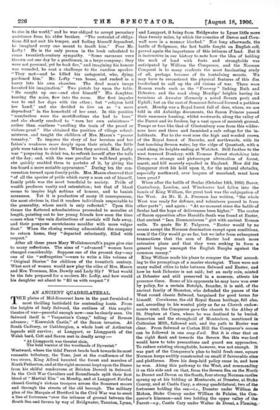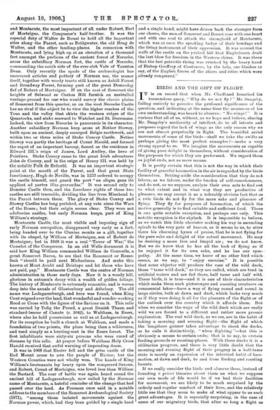AN ANCIENT QUADRILATERAL.
T"plains of Mid-Somerset have in the past furnished a most thrilling battlefield for contending hosts. From the heights of leafy Selwood, the outlines of this amphi- theatre of war—peaceful enough now—can be clearly seen. On Selwood itself is " Vespasian's Camp," telling of Roman advance ; " Kenwalch Castle," of the Saxon invasion. At South Cadbury, or Cathbregion, a whole host of Arthurian legends still survive ; at Langport, or Llongporth of the Welsh bard, Celt and Saxon met in deadly array :—
"At Llongporth was Geraint slain, The bold warrior of the woodlands of Dyvneint."
Westward, where the tidal Parret bends back towards its most romantic tributary, the Tone, just at the confluence of the two rivers, King Alfred haunted the forest and marshes of North Petherton, and at the right moment leapt upon the Danes from his skilful rendezvous at Brixton Deveril in Selwood. In the Civil War Cavaliers and Roundheads spilt their first blood at " Martial Elm " on Mendip, and at Langport Fairfax chased Goring's riotous troopers across the Somerset moors and through the streets of the old borough. The military plan of the Marquis of Hertford in the Civil War was to erect a line of fortresses "over the isthmus of ground between the South Sea and Severn by way of Bridgwater, Taunton, Lyme,
and Langport, it being from Bridgwater to Lynte little more than twenty miles, by which the counties of Devon and Corn- wall were in a manner blocked." Not long afterwards, the battle of Sedgmoor, the last battle fought on English soil, proved again the importance of this isthmus of land. But It is instructive in our history to note how the idea of holding the neck of land with forts and strongholds was anticipated by William the Conqueror, and the Norman Conquest is to many students the most fascinating study of all, perhaps because of its tantalising secrets. We may have to reconstruct the physical features of this dim borderland to call up the old visions of war. There were Roman roads such as the " Fossway " linking Bath and Ilchester, and the road along Mendips' heights having its terminus at Axwater (formerly a noted Severn port) and -Uphill; but on the east of Somerset Selwood formed a pathless tract. Mendip was a Royal forest full of deer, where, we are told in old Axbridge documents, the Saxon Princes passed their summers hunting, whilst westwards, along the valley of the Parret and its feeders, lay a vast space of moorish ground. Temps or tors like that of Glastonbury rose from this wilder- ness here and there and furnished a safe refuge for the in- habitants. Far to the west rose the high and wooded crown of the Royal forest of Neroche, and northwards, with its feet touching Severn water, lay the ridge of Quantock, with a road along its heights ending at Watchet. Still further to the west towered Dunkery, with Exmoor Forest stretching into Devon,—a strange and picturesque alternation of forest, marsh, and hill scarcely equalled in England. How did the Conqueror rivet his hold upon it, for the natural obstacles, especially northward, over leagues of moorland, must have been great ?
When after the battle of Senlac (October 14th, 1066) Dover, Canterbury, London, and Winchester had fallen into the hands of King William, the great task was the subjugation of the West. As Mr. E. A. Freeman has written, "the whole West was ready for defence, and volunteers poured in from other parts "; and again : "At no moment since the battle of Senlac had the hope of deliverance been higher." The centre of Saxon opposition after Harold's death was found at Exeter, that ancient " Isca Dnmnoniorum " girt with ancient Roman walls. To quote Sir F. Palgrave, " Exeter would by no means accept the Norman domination except upon conditions, even if the City would go so far, but we infer from subsequent transactions that the men of Exeter had much more extensive plans and that they were seeking to form a general league amongst the English Burghs against the common enemy."
King William made his plans to conquer the West accord- ing to the promptings of a master strategist. There were not many walled cities to take between Selwood and Exeter, and how he took Ilchester is not said; but an early coin, minted at Ilchester and still preserved in a museum, attests his presence there. Some of his opponents he may have won over by policy, for a certain Botolph, founder, it is said, of the ancient family of Stourton, who defended the passes of the West round classic Selwood, bargained for good terms for himself. Crewkerne, the old Royal Saxon heritage, fell also, and, according to his wonted piety as far as Church endow- ments went, the Conqueror gave the church to the Abbey of St. Stephen at Caen, where he was destined to be buried. Somerton and the stronghold of Montecleve, mentioned in Cottonian MSS., followed snit, and the path to Exeter was clear. From Selwood or Corton Hill the Conqueror's course can be followed in one coup d'ecil. But it is clear that on the right flank and towards the Severn Sea this war-lord would have to take precautions and guard sea approaches.' To reduce existing strongholds, however, was not enough. It was part of the Conqueror's plan to build fresh ones, square Norman keeps swiftly constructed on small if favourable sites and platforms. Here his deep-laid policy came in, and here he won. Along this pathway to the West, and commanding it on this side and on that, from the Severn Sea on the North to Dorset and Devon on the South, four strong Norman castles sprung np at his bidding at Montacute, at Dunster, at Stoke Conroy, and at Castle Cary, a strong quadrilateral, two of the fortresses holding the sea--i.e., Dunster under William de Mohan, Stoke Courcy under William de Falaise, the Con- queror's kinsman—and two holding the upper valley of the Parret—e.g., Castle Cary under Walter de Douai, a Fleming, • and Monfaente, the Meet important of all, tinder Robert, Earl of Mortaigne, the Conqueror's half-brother. It wad the especial duty of Walter de Donal to hold all the important sites along the Parret, such as Bridgwater, the old Brag de Walter, and the other landing-plates. In connexion with Montacute, and lying high up at an elevation of a thousand feet amongst the pnrliens of the ancient forest of Neroche, arose the ettbsidiary Norman fort, the castle of Neroobe, commanding the south side of the ever-rich Yale of Taunton Dean. Only recently the spade of the archaeologist has uncovered articles and pottery of Norman use, the manor itself, together with woody tracts still known as Asbill Forest and Broadway Forest, forming part of the great Domesday fief of Robert of Mortaigne. If on the east of Somerset the heights Of Seiwood or Cortem Hill furnish an nnrivalled vantage-ground for one who would survey the classic plains of Somerset from this quarter, so on the west Nervelie Castle has no rival if the object be to view the higher reaches of the Tone and the valley that skirts the western ridges of the Quantocks, and sinks seaward to Watchet and St. Deeumatts. Indeed, the view from Neroche is panoramic in its character. Another subsidiary Norman keep arose at Nether Stowey, built upon an ancient, deeply escarped Belgic earthwork, and within two or three miles of Stoke Courcy Castle. Nether Stowey was partly the heritage of Count Harold, and formed the caput of an important barony, famed as the residence in Edward III.'s reign of James, Lord Andley, the hero of Poictiers. Stoke Courcy came to the great Irish adventurer John de Conroy, and in the reign of Henry III. was held by the notable Fulk de Brent& It was an important strategic point at the mouth of the Parret, and that great State functionary, Efugh de Neville, was in 1233 ordered to occupy the castle himself, and guard the port " ne aliqua gene ibi applicet ad partes illas gravandas." It was second only to Dunster Castle then, and the foreshore rights of these two castles are still traceable, dividing the line from Minehead to the Parret between them. The glory of Stoke Conroy and Stowey Castles has long perished, at any rate since the Wars of the Roses ; but their origin seems clear. They were not adulterine castles, but early Norman keeps, part of King William's strategy.
Montacute Castle, the most visible and imposing sign of early Norman occupation, disappeared very early as a fort, being banded over to the Cluniac monks as a gift, together with its chapel, by William of Mortaigne, son of Robert de Mortaigne ; but in 1068 it was a real " Tower of War," the Camelot of the Conqueror. In an old Wells document it is said how King William commanded William de Courcelle, a great Somerset Baron, to see that the Romescot or Rome- feoh "should be paid next Michaelmas. And make this known at Mont Acubt and Bristoye and let those who have not paid, pay." Montaoute Castle was the centre of Norman administration in those early days. Now it is a woody hill, glorious in autumn's decay with a wealth of golden foliage. The history of Montacute is extremely romantic, and is woven deep into the annals of Glastonbury and Athelney. The old name was Lodegaresburgh, and here VW found, when King Cant reigned over the land, that wonderful and wonder-working Rood or Cross with the figure of the Saviour on it. This relic was carried by Tofig the Proud, a great Danish Thane, and standard-bearer of Canute (c. 1042), to Waltham, in Essex, where also be held possessions as well as at Lodegaresburgh. For its reception he built a church at Waltham, and made a foundation of two priests, the place being then a wilderness, and used simply as a hunting-seat in the Essex forest. The first inhabitants were sixty-six persons who were cured of diseases by this relic. At prayer .before Waltham Holy Cross Harold received that awful warning of impending doom.
It was in 1068 that Exeter fell and the grim castle of the Red Meta arose to awe the people of Exeter; but the Western Counties were not wholly won. The hands of King William's lieutenants lay heavy upon the conquered Saxons, and Robert, Count of Mortaigne, was loved leas than William the Bastard. The roar of battle was again heard round the ancient hill of Lodegaresburgh, now ogled by the Norman name of Montacute, a hateful reminder of the change that had passed over the land. As Freeman once said in a notable address to the members of the Somerset Archaeological Society (1871), " among those isolated movements against the Norman power, which, had they been guided by a single head
and a single band, might base driven heck the stranger from our shores, the men of Somerset and Dorset rose with one heart and with one soul to attack the stronghold of Montacute, which wan at once the speaking badge of their bondage and the living instrument of their oppression. It was around the walls of the castle on the peaked hill that Englishmen dealt the last blow for freedom in the Western shires. It was there that the last patriotic rising was crushed by the heavy hand of Bishop Geoffrey of Coutances, by the help, one blushes to say, of the English forces of the shires and cities which were already conquered."



































 Previous page
Previous page